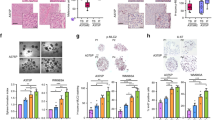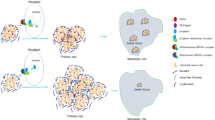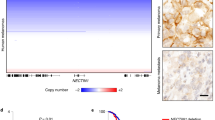Abstract
Cell-type-specific signalling determines cell fate under physiological conditions, but it is increasingly apparent that also in cancer development the impact of any given oncogenic pathway on the individual cancer pathology is dependent on cell-lineage-specific molecular traits. For instance in colon and liver cancer canonical Wnt signalling produces increased cytoplasmic and nuclear localised beta-catenin, which correlates with invasion and poor prognosis. In contrast, in melanoma increased cytoplasmic and nuclear beta-catenin is currently emerging as a marker for good prognosis, and thus seems to have a different function compared with other cancer types; however, this function is unknown. We discovered that in contrast to its function in other cancers, in melanoma, beta-catenin blocks invasion. We demonstrate that this opposing role of nuclear beta-catenin in melanoma is mediated through MITF, a melanoma-specific protein that defines the lineage background of this cancer type. Downstream of beta-catenin MITF not only suppresses the Rho-GTPase-regulated cell morphology of invading melanoma cells, but also interferes with beta-catenin-induced expression of the essential collagenase MT1-MMP, thus affecting all aspects of an invasive phenotype. Importantly, overexpression of MITF in invasive colon cancer cells modifies beta-catenin-directed signalling and induces a ‘melanoma phenotype’. In summary, the cell-type-specific presence of MITF in melanoma affects beta-catenin's pro-invasive properties otherwise active in colon or liver cancer. Thus our study reveals the general importance of considering cell-type-specific signalling for the accurate interpretation of tumour markers and ultimately for the design of rational therapies.
This is a preview of subscription content, access via your institution
Access options
Subscribe to this journal
Receive 50 print issues and online access
$259.00 per year
only $5.18 per issue
Buy this article
- Purchase on Springer Link
- Instant access to full article PDF
Prices may be subject to local taxes which are calculated during checkout








Similar content being viewed by others
References
Abbott A . (2003). Cell culture: biology’s new dimension. Nature 424: 870–872.
Adachi Y, Yamamoto H, Itoh F, Arimura Y, Nishi M, Endo T et al. (2001). Clinicopathologic and prognostic significance of matrilysin expression at the invasive front in human colorectal cancers. Int J Cancer 95: 290–294.
Arozarena I, Sanchez-Laorden B, Packer L, Hidalgo-Carcedo C, Hayward R, Viros A et al. (2011). Oncogenic BRAF induces melanoma cell invasion by downregulating the cGMP-specific phosphodiesterase PDE5A. Cancer Cell 19: 45–57.
Bachmann IM, Straume O, Puntervoll HE, Kalvenes MB, Akslen LA . (2005). Importance of P-cadherin, beta-catenin, and Wnt5a/frizzled for progression of melanocytic tumors and prognosis in cutaneous melanoma. Clin Cancer Res 11: 8606–8614.
Boye K, Nesland JM, Sandstad B, Maelandsmo GM, Flatmark K . (2010). Nuclear S100A4 is a novel prognostic marker in colorectal cancer. Eur J Cancer 46: 2919–2925.
Busca R, Ballotti R . (2000). Cyclic AMP a key messenger in the regulation of skin pigmentation. Pigment Cell Res 13: 60–69.
Carreira S, Goodall J, Denat L, Rodriguez M, Nuciforo P, Hoek KS et al. (2006). Mitf regulation of Dia1 controls melanoma proliferation and invasiveness. Genes Dev 20: 3426–3439.
Charras G, Paluch E . (2008). Blebs lead the way: how to migrate without lamellipodia. Nat Rev Mol Cell Biol 9: 730–736.
Chien AJ, Moore EC, Lonsdorf AS, Kulikauskas RM, Rothberg BG, Berger AJ et al. (2009). Activated Wnt/beta-catenin signaling in melanoma is associated with decreased proliferation in patient tumors and a murine melanoma model. Proc Natl Acad Sci USA 106: 1193–1198.
Delmas V, Beermann F, Martinozzi S, Carreira S, Ackermann J, Kumasaka M et al. (2007). Beta-catenin induces immortalization of melanocytes by suppressing p16INK4a expression and cooperates with N-Ras in melanoma development. Genes Dev 21: 2923–2935.
Demirkan NC, Kesen Z, Akdag B, Larue L, Delmas V . (2007). The effect of the sun on expression of beta-catenin, p16 and cyclin d1 proteins in melanocytic lesions. Clin Exp Dermatol 32: 733–739.
Fackler OT, Grosse R . (2008). Cell motility through plasma membrane blebbing. J Cell Biol 181: 879–884.
Giles RH, van Es JH, Clevers H . (2003). Caught up in a Wnt storm: Wnt signaling in cancer. Biochim Biophys Acta 1653: 1–24.
Gould Rothberg BE, Berger AJ, Molinaro AM, Subtil A, Krauthammer MO, Camp RL et al. (2009). Melanoma prognostic model using tissue microarrays and genetic algorithms. J Clin Oncol 27: 5772–5780.
Hlubek F, Spaderna S, Jung A, Kirchner T, Brabletz T . (2004). Beta-catenin activates a coordinated expression of the proinvasive factors laminin-5 gamma2 chain and MT1-MMP in colorectal carcinomas. Int J Cancer 108: 321–326.
Hoeck KS, Eichhoff OM, Schlegel NC, Döbbeling U, Kobert N, Schaerer L et al. (2008). In vivo switching of human melanoma cells between proliferative and invasive states. Cancer Res 68: 650–656.
Hoek KS, Schlegel NC, Brafford P, Sucker A, Ugurel S, Kumar R et al. (2006). Metastatic potential of melanomas defined by specific gene expression profiles with no BRAF signature. Pigment Cell Res 19: 290–302.
Itoh Y . (2006). MT1-MMP: a key regulator of cell migration in tissue. IUBMB Life 58: 589–596.
Jung A, Schrauder M, Oswald U, Knoll C, Sellberg P, Palmqvist R et al. (2001). The invasion front of human colorectal adenocarcinomas shows co-localization of nuclear beta-catenin, cyclin D1, and p16INK4A and is a region of low proliferation. Am J Pathol 159: 1613–1617.
Kageshita T, Hamby CV, Ishihara T, Matsumoto K, Saida T, Ono T . (2001). Loss of beta-catenin expression associated with disease progression in malignant melanoma. Br J Dermatol 145: 210–216.
Kawasaki Y, Sato R, Akiyama T . (2003). Mutated APC and Asef are involved in the migration of colorectal tumour cells. Nat Cell Biol 5: 211–215.
Kumar SR, Scehnet JS, Ley EJ, Singh J, Krasnoperov V, Liu R et al. (2009). Preferential induction of EphB4 over EphB2 and its implication in colorectal cancer progression. Cancer Res 69: 3736–3745.
Levy C, Khaled M, Fisher DE . (2006). MITF: master regulator of melanocyte development and melanoma oncogene. Trends Mol Med 12: 406–414.
Liu L, Zhu XD, Wang WQ, Shen Y, Qin Y, Ren ZG et al. (2010). Activation of beta-catenin by hypoxia in hepatocellular carcinoma contributes to enhanced metastatic potential and poor prognosis. Clin Cancer Res 16: 2740–2750.
Maelandsmo GM, Holm R, Nesland JM, Fodstad O, Florenes VA . (2003). Reduced beta-catenin expression in the cytoplasm of advanced-stage superficial spreading malignant melanoma. Clin Cancer Res 9: 3383–3388.
Nazarian RM, Prieto VG, Elder DE, Duncan LM . (2010). Melanoma biomarker expression in melanocytic tumor progression: a tissue microarray study. J Cutan Pathol 37 (Suppl 1): 41–47.
O'Connell MP, Weeraratna AT . (2009). Hear the Wnt Ror: how melanoma cells adjust to changes in Wnt. Pigment Cell Melanoma Res 22: 724–739.
Omholt K, Platz A, Ringborg U, Hansson J . (2001). Cytoplasmic and nuclear accumulation of beta-catenin is rarely caused by CTNNB1 exon 3 mutations in cutaneous malignant melanoma. Int J Cancer 92: 839–842.
Pecina-Slaus N, Zigmund M, Kusec V, Martic TN, Cacic M, Slaus M . (2007). E-cadherin and beta-catenin expression patterns in malignant melanoma assessed by image analysis. J Cutan Pathol 34: 239–246.
Pinner S, Jordan P, Sharrock K, Bazley L, Collinson L, Marais R et al. (2009). Intravital imaging reveals transient changes in pigment production and Brn2 expression during metastatic melanoma dissemination. Cancer Res 69: 7969–7977.
Rimm DL, Caca K, Hu G, Harrison FB, Fearon ER . (1999). Frequent nuclear/cytoplasmic localization of beta-catenin without exon 3 mutations in malignant melanoma. Am J Pathol 154: 325–329.
Robbins PF, el-Gamil M, Li YF, Topalian SL, Rivoltini L, Sakaguchi K et al. (1995). Cloning of a new gene encoding an antigen recognized by melanoma-specific HLA-A24-restricted tumor-infiltrating lymphocytes. J Immunol 154: 5944–5950.
Rubinfeld B, Robbins P, El-Gamil M, Albert I, Porfiri E, Polakis P . (1997). Stabilization of beta-catenin by genetic defects in melanoma cell lines. Science 275: 1790–1792.
Sabeh F, Ota I, Holmbeck K, Birkedal-Hansen H, Soloway P, Balbin M et al. (2004). Tumor cell traffic through the extracellular matrix is controlled by the membrane-anchored collagenase MT1-MMP. J Cell Biol 167: 769–781.
Sabeh F, Shimizu-Hirota R, Weiss SJ . (2009). Protease-dependent versus -independent cancer cell invasion programs: three-dimensional amoeboid movement revisited. J Cell Biol 185: 11–19.
Sahai E, Marshall CJ . (2003). Differing modes of tumour cell invasion have distinct requirements for Rho/ROCK signalling and extracellular proteolysis. Nat Cell Biol 5: 711–719.
Salti GI, Manougian T, Farolan M, Shilkaitis A, Majumdar D, Das Gupta TK . (2000). Micropthalmia transcription factor: a new prognostic marker in intermediate-thickness cutaneous malignant melanoma. Cancer Res 60: 5012–5016.
Schepsky A, Bruser K, Gunnarsson GJ, Goodall J, Hallsson JH, Goding CR et al. (2006). The microphthalmia-associated transcription factor Mitf interacts with beta-catenin to determine target gene expression. Mol Cell Biol 26: 8914–8927.
Stein U, Arlt F, Walther W, Smith J, Waldman T, Harris ED et al. (2006). The metastasis-associated gene S100A4 is a novel target of beta-catenin/T-cell factor signaling in colon cancer. Gastroenterology 131: 1486–1500.
Takeda K, Yasumoto K, Takada R, Takada S, Watanabe K, Udono T et al. (2000). Induction of melanocyte-specific microphthalmia-associated transcription factor by Wnt-3a. J Biol Chem 275: 14013–14016.
van de Wetering M, Cavallo R, Dooijes D, van Beest M, van Es J, Loureiro J et al. (1997). Armadillo coactivates transcription driven by the product of the Drosophila segment polarity gene dTCF. Cell 88: 789–799.
Wagenaar-Miller RA, Gorden L, Matrisian LM . (2004). Matrix metalloproteinases in colorectal cancer: is it worth talking about? Cancer Metastasis Rev 23: 119–135.
Wellbrock C, Marais R . (2005). Elevated expression of MITF counteracts B-RAF-stimulated melanocyte and melanoma cell proliferation. J Cell Biol 170: 703–708.
Wellbrock C, Ogilvie L, Hedley D, Karasarides M, Martin J, Niculescu-Duvaz D et al. (2004). V599EB-RAF is an oncogene in melanocytes. Cancer Res 64: 2338–2342.
Wellbrock C, Rana S, Paterson H, Pickersgill H, Brummelkamp T, Marais R . (2008). Oncogenic BRAF regulates melanoma proliferation through the lineage specific factor MITF. PLoS One 3: e2734.
Wellbrock C, Weisser C, Geissinger E, Troppmair J, Schartl M . (2002). Activation of p59(Fyn) leads to melanocyte dedifferentiation by influencing MKP-1-regulated mitogen-activated protein kinase signaling. J Biol Chem 277: 6443–6454.
Widlund HR, Horstmann MA, Price ER, Cui J, Lessnick SL, Wu M et al. (2002). Beta-catenin-induced melanoma growth requires the downstream target Microphthalmia-associated transcription factor. J Cell Biol 158: 1079–1087.
Wolf K, Mazo I, Leung H, Engelke K, von Andrian UH, Deryugina EI et al. (2003). Compensation mechanism in tumor cell migration: mesenchymal-amoeboid transition after blocking of pericellular proteolysis. J Cell Biol 160: 267–277.
Yamaguchi Y, Itami S, Watabe H, Yasumoto K, Abdel-Malek ZA, Kubo T et al. (2004). Mesenchymal-epithelial interactions in the skin: increased expression of dickkopf1 by palmoplantar fibroblasts inhibits melanocyte growth and differentiation. J Cell Biol 165: 275–285.
Zulehner G, Mikula M, Schneller D, van Zijl F, Huber H, Sieghart W et al. (2010). Nuclear beta-catenin induces an early liver progenitor phenotype in hepatocellular carcinoma and promotes tumor recurrence. Am J Pathol 176: 472–481.
Acknowledgements
We thank Steven Rosenberg (NCI) for the 501mel, 888mel and 1290mel cells and Hector Palmer (Vall d’Hebron) for the beta-catenin reporter plasmids. We thank Peter March for his help with microscopy. The Bioimaging Facility microscopes were funded by the BBSRC, the Wellcome Trust and the University of Manchester Strategic Fund. This work was funded by Cancer Research UK (grant C11591/A10202) and the BBSRC (grant BB/G001111/1).
Author information
Authors and Affiliations
Corresponding author
Ethics declarations
Competing interests
The authors declare no conflict of interest.
Additional information
Supplementary Information accompanies the paper on the Oncogene website
Rights and permissions
About this article
Cite this article
Arozarena, I., Bischof, H., Gilby, D. et al. In melanoma, beta-catenin is a suppressor of invasion. Oncogene 30, 4531–4543 (2011). https://doi.org/10.1038/onc.2011.162
Received:
Revised:
Accepted:
Published:
Issue Date:
DOI: https://doi.org/10.1038/onc.2011.162
Keywords
This article is cited by
-
BRN2 is a non-canonical melanoma tumor-suppressor
Nature Communications (2021)
-
Wingless modulates activator protein-1-mediated tumor invasion
Oncogene (2019)
-
Tspan8-β-catenin positive feedback loop promotes melanoma invasion
Oncogene (2019)
-
WNT/β-catenin signaling regulates mitochondrial activity to alter the oncogenic potential of melanoma in a PTEN-dependent manner
Oncogene (2017)
-
Microphthalmia-associated transcription factor suppresses invasion by reducing intracellular GTP pools
Oncogene (2017)



